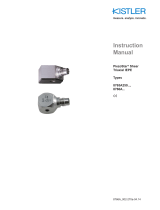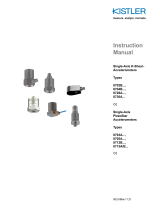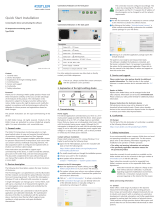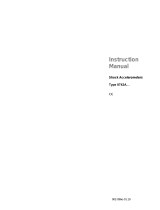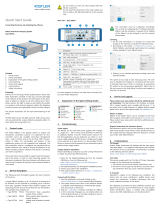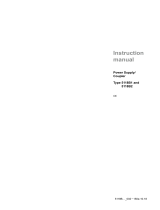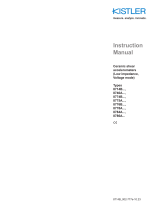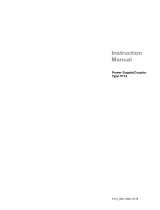
Instruction
Manual
K-SHEAR
Rotational
Accelerometers
Type 8838 and 8840
ä
002-102e-06.00
(B08.8838/40e)

Pages 1... 14
B08.8838/40e-6.00
Operating Instructions
K-SHEAR
Rotational Accelerometers
Series 8838 and 8840
Instrument Corp., 75 John Glenn Drive, Amherst, NY 14228, USA
Phone (716) 691-5100, Fax (716) 691-5226, e-mail kicsales@ kistler.com
Instrumente AG Winterthur, Postfach 304, CH-8408 Winterthur, Switzerland
Phone (052) 224 11 11, Fax (052) 224 14 14, e-mail [email protected]

Types 8838/40 K-Shear Rotational Accelerometers Page 2
B08.8838/40e-6.00
Contents
Section Page
Contents............................................................................................................................................2
1. Introduction ..................................................................................................................................4
2. Important Guidelines...................................................................................................................4
2.1 For your safety................................................................................................................4
2.2 Precautions.....................................................................................................................4
2.3 Using This Manual..........................................................................................................5
2.4 K-Shear Accelerometer Types........................................................................................5
2.5 Manual Nomenclature.....................................................................................................5
3. General Description.....................................................................................................................5
3.1 Supplied Items ................................................................................................................6
4. Technical Information, Functional Description ........................................................................6
4.1 Piezoelectric Measurement Concept..............................................................................6
4.2 K-Shear Background....................................................................................................7
4.3 Low Impedance Output...................................................................................................7
5. Installation ....................................................................................................................................8
5.1 General ...........................................................................................................................8
5.2 Surface Preparation........................................................................................................8
5.3 Stud Mounting.................................................................................................................8
5.4 Direct Adhesive Mounting...............................................................................................9
5.5 Mounting with Wax……………………………………………………………………………..10
5.6 Magnetic Mounting …………………………………………………………………………….10
5.7 Summary of Mounting Methods......................................................................................11
5.8 Securing Cables..............................................................................................................12
5.9 Mass Loading Effects......................................................................................................10
6. Operation ......................................................................................................................................10
6.1 Powering.........................................................................................................................10
6.2 Ground Loops .................................................................................................................11
7. Maintenance and Calibration......................................................................................................11
7.1 General ...........................................................................................................................11
7.2 Trouble Shooting.............................................................................................................11
7.3 Repairs............................................................................................................................11
7.4 Cleaning..........................................................................................................................11

Types 8838/40 K-Shear Rotational Accelerometers Page 3
B08.8838/40e-6.00
7.5 Calibration…………………………………………………………………………….…………11
8. Accessories..................................................................................................................................12
8.1 Cable...............................................................................................................................12
9. Warranty........................................................................................................................................13
Appendix...........................................................................................................................................14

Types 8838/40 K-Shear Rotational Accelerometers Page 4
B08.8838/40e-6.00
1. Introduction By choosing Kistler K-SHEAR rotational accelerometers you have opted
for an instrument distinguished by precision, long life and technical
innovation. Please read these instructions carefully before installing and
operating these instruments.
Kistler offers a wide selection of measuring instruments and comprehensive
systems including:
• Quartz and ceramic sensors for force, pressure, acceleration,
shock, vibration and strain.
• Associated signal conditioners and accessories.
• Piezoresistive pressure transducers and transmitters with
associated amplifiers.
Kistler can also provide entire systems for special purposes in the
automotive industry, plastics processing, and biomechanics. Our general
catalog provides information on Kistler products and services. Detailed
technical data sheets are available on most products offered.
Worldwide customer service is at your disposal should you have any
questions regarding this or other Kistler products. Information on your
specific application is also available from Kistler.
2. Important Guidelines
To ensure your personal safety, please observe the safety guidelines in
this section.
2.1 For your safety
• Carefully follow the installation information contained in section 5
of this manual.
• Do not drop the instrument.
• Store in the case provided and in a clean, dry environment.
• Power the instrument in accordance with the instructions in
section 6 of this manual.
2.2 Precautions
Kistler sensors are thoroughly tested before leaving the factory. To
maintain safe and reliable operation, it is important to follow the
instructions herein.
• Do not mount accelerometers on high voltage surfaces.
• Keep cable clear of power lines and open machinery.
• Never operate or store the unit beyond the specified temperature
range.
• Do not exceed the maximum specified current.
• Never exceed the maximum specified voltage.

Types 8838/40 K-Shear Rotational Accelerometers Page 5
B08.8838/40e-6.00
• Follow the instructions for mounting. Do not over tighten.
• Do not expose the unit to excessive shock, i.e., by using a
hammer or dropping the unit.
• When not in use, store the accelerometer in the container
supplied. Always store in a clean, dry area.
• Keep the connector clean and covered when not in use
• Follow the recommendations in section 7.4
2.3 Using This Manual
Information contained herein includes a technical description, installation
and operating instructions, powering and considerations for cable length.
Section 8 contains cables available to assist with your measurement
needs.
It is recommended that the entire manual be read prior to installation and
operation of K-SHEAR rotational accelerometers. The user who has prior
experience with voltage mode piezoelectric accelerometers may want to
confine reading to particular sections of interest.
We have endeavored to arrange these instructions in a manner that
allows for easy location of topics of interest. Your Kistler representative is
also available to assist with any questions.
Information contained herein may be subject to change.
2.4 K-Shear Accelerometer Types
This manual is applicable to K-SHEARÜ rotational accelerometers listed
on the title page.
2.5 Manual Nomenclature
Throughout this manual some special designations and nomenclature are
used for specific terms and concepts relating to K-SHEAR rotational
accelerometers. These are explained in Table 1.
Term Definition
FS Full-Scale
Table 1: Manual Nomenclature
3. General Description
Kistler K-SHEAR rotational accelerometers are shear mode shock and
vibration measuring instruments. A self-generating piezoelectric sensing
element is used in conjunction with signal processing electronics that converts
the charge generated by the mechanical system into a low impedance,
voltage mode output signal. These accelerometers do not use the standard
voltage mode piezoelectric sensor couplers but are powered by any
commercially available 20 to 30 VDC power supply.

Types 8838/40 K-Shear Rotational Accelerometers Page 6
B08.8838/40e-6.00
The 8838 and 8840 differ from conventional vibration accelerometers with a
novel complement of two shear mode sensors that are designed to respond to
two distinctly different forms of rotational acceleration. Type 8838 senses
axial rotation, with the mounting screw as the axis, while the 8840 senses
lateral rotational acceleration. Unlike most accelerometers, the sensitivity of
this series is expressed these terms - μV/rad/s2.
Types 8838 and 8840 share the same appearance as shown in Figure 1.
Figure1: View of rotational accelerometers showing
center mounting hole
A center hole is intended for a cap screw mounting arrangement.
3.1 Supplied Items
Types 8838 and 8840 rotational accelerometers are designed for screw
mounting and are supplied with a 10-32 x ¾ mounting screw, M5 x 20mm
mounting screw plus this B8.8838/40e instruction manual. Optional items
are listed in the data sheet. The data sheet is shown on the Kistler
website at www.kistler.com
4. Technical Information, Functional Description
4.1 Piezoelectric Measurement Concept
Piezoelectric accelerometers convert acceleration into an electric charge.
The charge derived by the accelerometer is proportional to the force
acting on the internal quartz (piezoelectric) element. Accordingly, the
mechanical variable (acceleration) is derived from a force measurement.
4.1.1 Measurement Planes
Rotational accelerometers 8838 and 8840 share the same general
construction but differ in respective measuring planes. Type 8838
responds to oscillations occurring about the unit’s mounting axis as shown
in Figure 2.

Types 8838/40 K-Shear Rotational Accelerometers Page 7
B08.8838/40e-6.00
Figure 2: Measurement Planes for rotational
accelerometers
Type 8840 measures rotational oscillations laterally induced to its
mounting base.
4.2 K-Shear Background
The sensing assembly consists of a center post, quartz piezoelectric
crystals, seismic mass and a preload bolt. Since the unit is operated in a
shear arrangement it will sense motion perpendicular to the base. When
the accelerometer is attached to a vibrating structure, the mass exerts a
shear force on the quartz piezoelectric crystal. This applied force causes
the piezoelectric material to produce an electric charge. Since force is
mass times acceleration (from Newton's second law), the charge
produced is proportional to acceleration, since m is constant. This is
represented by:
a
F
m
=
The K-SHEAR sensing element offers many advantages over previous
shear and compression mode designs. Because of shear construction
the accelerometer is insensitive to thermal transients, transverse (cross-
axis) motion and the effects of base strain.
4.3 Low Impedance Output
Contained within the accelerometer housing is a miniature electronic
circuit. This circuit converts the high impedance charge signal generated
by the piezoelectric element into a low impedance voltage output signal
with an output impedance typically below 100 Ohms.
The low impedance output voltage provides immunity to EMI, therefore
long cable lengths can be used if necessary. All decoupling circuitry is

Types 8838/40 K-Shear Rotational Accelerometers Page 8
B08.8838/40e-6.00
internal to this design and a simple power supply of 20 to 30 Volts is all
that is required for operation. The calibration factor for these
accelerometers are given in μV/rad/s2.
A typical measuring system using the 8838 or 8840 is shown in Figure 3.
Figure 3: Diagram of an Acceleration System
1. Accelerometer
2. Optional extension cable
3. Output cable – Type 1786 or 1592M1
Optional cables are detailed in section 8.1.
5. Installation
5.1 General
For proper operation of K-SHEAR rotational accelerometers, care must be
taken during the installation process. Careful installation will result in
optimal high frequency response, accuracy and reliability.
5.2 Surface Preparation
A smooth, flat surface is necessary. If the surface is not completely flat,
the coupling between the accelerometer and the test article introduces
distortion into the measurement. A rough surface creates voids between
the mounting surfaces that reduce high frequency transmissibility.
For optimum frequency response, the surface and hole preparation
should be according to the instructions in Table 3. The roughness should
not exceed 32 microinches (0.8 micrometers).
5.3 Screw Mounting
Types 8838 and 8840 rotational accelerometers are specifically designed
for screw mounting. Socket head cap screw 431-0475-003, 10-32 x .75”
long and screw 431-0494-001, M5 x 20mm long are included with the
accelerometer and are the only screws recommended for mounting. Note
a tightening torque of 18 ±2 in-lb applies to screw mounting.

Types 8838/40 K-Shear Rotational Accelerometers Page 9
B08.8838/40e-6.00
The following guidelines should be followed when screw mounting
accelerometers.
1. Drill and tap an adequate hole to ensure a flush mount of the
accelerometer. Make sure the stud does not bottom out and
firmly secures the accelerometer. A chamfer should be machined
at the top of the mounting hole to ensure that the base of the
accelerometer makes full contact with the mounting surface
(See Table 3).
2. Completely clean the surface prior to mounting.
3. Apply a thin coat of silicon grease to both the accelerometer and
mounting surface.
4. Always use the proper sockets and a torque wrench when
installing accelerometers. Tighten the accelerometer to the torque
specified on the individually supplied calibration certificate or as
specified in Table 2. Do Not Over Tighten.
in-lbs Nm Accelerometer Types
18 ±2 2 ±0.2 8838 and 8840
Table 2: Recommended Mounting Torque
Screw D L1 inch [mm] L2 inch [mm}
431-0475-003 10-32 .16 [4.0]
.32 [8.0]
431-0494-001 M5 .16 [4.0]
.32 [8.0]
Table 3: Screw Mounting Preparation
.
5.4 Other Mounting Methods
Screw mounting rotational accelerometers is the only recommended
mounting method. Adhesives, wax and magnet mountings do not offer
L
1
L
2
D
0.0008
[0.08]
0.0004
[0.01]
32[N6]

Types 8838/40 K-Shear Rotational Accelerometers Page 10
B08.8838/40e-6.00
the necessary holding power against the impacts typically encountered
with rotational measurements.
5.8 Securing Cables
The cable to the accelerometer should be secured with the usual care
observed in good instrumentation practice. Use a radius that will not
fatigue the three conductors inside the cable. It is recommended that
cables be secured to the vibrating surface, observing the type of rotational
oscillation, to minimize cable and connector fatigue failures. Secure
cables with a cable clamp. Tape is acceptable on temporary installations.
See Section 8.5 for information on cables available from Kistler.
6. Operation
K-SHEAR rotational accelerometers are easily installed, requiring only
operational voltage. No coupler is required. A single cable is used to conduct
the operating voltage to the accelerometer electronics and to provide the
output to readout equipment.
6.1 Powering
Operating power is applied to the accelerometer or cable pin as shown in
Figure 2. The ground is common to the output signal ground. Power
requirements are 20 to 30 Volts DC at least 4mA.
Figure 4: Connector configuration showing common
ground

Types 8838/40 K-Shear Rotational Accelerometers Page 11
B08.8838/40e-6.00
6.2 Ground Loops
Types 8838 and 8840 rotational accelerometers are ground isolated,
which effectively eliminates the accelerometer from a potential ground
loop. Other components of the measuring system should inspected for
grounding paths that could establish a ground loop and associated 50-60
Hz noise.
7. Maintenance and Calibration
7.1 General
The sealed construction of K-SHEAR rotational accelerometers precludes
any internal maintenance or repairs. External cleaning is important as
covered in Section 7.4.
7.2 Trouble Shooting
Should the user experience any problems with a K-SHEAR rotational
accelerometer, the following procedure should be followed.
Check for possible intermittent cables. Faulty cables are the most
common cause of accelerometer measurement problems. The
application of a test signal at the accelerometer end of the cable is an
effective means to determine if the problem is accelerometer, cable, or
measurement instrument related.
7.3 Repairs
Field repair is not possible. Please return the accelerometer to the factory
together with a statement of problems encountered and unit serial
number. Recalibration is recommended when returning an accelerometer
to the factory. Please contact the factory and obtain a return authorization
number prior to return.
7.4 Cleaning
Clean the transducer with Isopropyl alcohol and lint-free paper wipes.
Never use air-blast to clean the connector; it may deposit a water vapor
film.
Do not us an abrasive on the base surface. This can affect the flatness
thereby reducing high frequency transmissibility.
7.5 Calibration
Calibration services are available from Kistler. Kistler acceptance test
instrumentation is in conformance with ANSI/NCSL Z-540. A calibration
certificate will be supplied showing calibration results from standards
traceable to NIST.

Types 8838/40 K-Shear Rotational Accelerometers Page 12
B08.8838/40e-6.00
8. Accessories
8.1 Cable
Types 8838 and 8840 rotational accelerometers are furnished without
cables. Optional cables are identical for both types and listed in Table 4.
Kistler Cable Type Cable Description
1578A2 Extension cable, 4-pin Microtech positive to 4-pin
Microtech negative, length is 2 meters
1578Asp Same as above except in a custom length
1592M1 Output cable, 4-pin Microtech negative to pigtails,
length is 2 meters
1786 Output cable, 4-pin Microtech negative to BNC
and banana plug pair, length is 2.6 meters
Table 4: Optional cables for rotational accelerometers
Cable Type 1786 is shown in Figure 5.
Figure 5: Configuration of output cable 1786
Call Kistler for special cable requirements.

Types 8838/40 K-Shear Rotational Accelerometers Page 13
B08.8838/40e-6.00
9. Warranty
The Kistler Instrument Corporation warrants all Kistler products to be free
from defects in material and workmanship. All such products are
warranted only under normal use and service.
For K-SHEAR triaxial, the period of warranty is 24 months from date of
shipment. For cables and adapters the warranty period is 12 months.
When returning items under warranty, said equipment shall be returned to
the Kistler Instrument Corporation prepaid. Full details relative to the claim
or malfunction shall accompany the shipment. No action will be taken
until these details are received. Please contact Kistler for a RETURN
AUTHORIZATION (RA) number before returning goods.
Settlement will be made at Kistler's discretion, either through repair or
replacement of the item in question or through issuance of full credit.
Damage occurring through misuse or mishandling, will not be covered by
this warranty.
This warranty is in lieu of all warranties expressed or implied, and of all
obligations or liabilities on the part of Kistler Instrument Corporation for
damages following the use or misuse of items supplied. Any unauthorized
disassembly or attempt at repair, shall void this warranty.
No agent or representative is authorized to assume for the Corporation
any liability except as set forth within this warranty document.

Types 8838/40 K-Shear Rotational Accelerometers Page 14
B08.8838/40e-6.00
Appendix
Specifications for Kistler accelerometers, accelerometer accessories and
many other instrumentation products are shown on the Kistler website
www.kistler.com.
This is a listing of information sheets and technical articles related to K-
SHEAR rotational accelerometer applications. Contact Kistler using the
information listed on the front cover of these instructions.
Information Sheets
Information Sheet Number Title
KI 8.002e Guidelines for Selecting an Accelerometer
Technical Article Reprints
Reprint Number Title
20.184 K-Shear Accelerometers
20.159 Lightweight Capacitive Accelerometer for Low
Frequency Measurements
K20.310 Force Limited Vibration Tests
20.148 PiezoBEAM Accelerometers: Reliable Design for
Modal Analysis

Disposal Instructions
for Electrical and Electronic Equipment
Do not discard old electronic instruments in municipal trash.
For disposal at end of life, please return this product to an
authorized local electronic waste disposal service or contact
the nearest Kistler Instrument sales office for return instruc-
tions.
©2005 , Kistler Instrumente AG, PO Box, Eulachstr. 22, CH-8408 Winterthur
Tel +41 52 224 11 11, Fax 224 14 14, info@kistler.com, www.kistler.com
This information corresponds to the current state of knowledge. Kistler reser-
ves the right to make technical changes. Liability for consequential damage
resulting from the use of Kistler products is excluded.
002-331e-09.05

/
